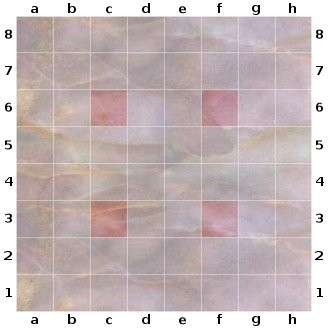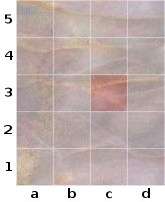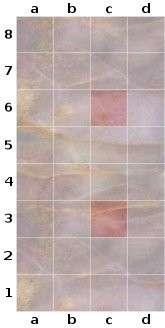Arimaa/Introduction to Strategy/Frames
< Arimaa < Introduction to Strategy

| |||||||||||||||||||||||||||||||||||||||||||||||||||||||||||||||||||||||||
| In this game, the gold elephant is pinned to the defense of the horse on c6, which is framed. | |||||||||||||||||||||||||||||||||||||||||||||||||||||||||||||||||||||||||
A piece which is on a trap square, surrounded on three sides by opposing pieces which prevent it from pushing its way off the trap square, has been framed. The lone friendly piece providing support is pinned, because as soon as it moves, the piece on the trap square will disappear. In the position at right, the gold elephant is pinned to the defense of the gold horse which has been framed on c6.
The simplest way to take advantage of a frame is to rotate out strong pieces holding the frame, replacing them with weaker ones. At right Silver can replace the elephant with the a5 horse, making the silver elephant the strongest free piece. Frames are most effective in the opening when the board is crowded and plentiful weak pieces are available for rotation. An otherwise attractive frame may not be worthwhile on a relatively empty board.
Even if rotation is impossible, the frame may be valuable. At right the silver camel has a freedom to attack that the gold camel does not, because of the difference in elephant mobility. The silver elephant can switch wings at any time to threaten the gold camel at no cost other than giving up the frame. In contrast, the gold elephant can't threaten the silver camel without abandoning the framed gold horse to instant capture.
A frame may be broken by the arrival of a piece strong enough to dislodge the framing piece or pieces on one side of the trap. If a piece on a trap gains a second supporter, it is no longer framed. At right only the gold camel would be strong enough to break the frame. In considering moving the camel to the western wing, Gold must judge whether the threat to break the frame is worth the damage that the silver camel will do on the eastern wing in the mean time.
In general, weak pieces are easier to frame, since more pieces are available to push them around. Similarly, it is easier to rotate pieces out of a frame of a weak piece. Such a frame can be worth almost as much as the capture of the piece, since the pinned elephant may simply be forced elsewhere. Frames of stronger pieces vary widely in value, depending on the framing sides' ability to rotate, and the opponent's ability to break the frame. A breakable frame can have negative value, since the formerly framed piece can become an attacker.
Elephant position
Suppose Gold is defending a piece framed on c6. It is usually better for the gold elephant to be on d6 than on c5:
- With the elephant on d6, a silver piece is forced to occupy c5 (except in the case of rabbit frames). This piece is vulnerable to capture threats in c3. In some cases, the elephant can abandon the frame to push the c5 piece to c4.
- The elephant on d6 prevents the framed piece from being pushed to d6 for a fork.
- d6 is a better attacking square for the elephant than c5. The reasons for this also apply to frames, especially if the frame can be broken and turned into an attack.
On the other hand, the elephant may be better placed on c5 if, for instance, there is a important fight happening around the c3 trap.

| |||||||||||||||||||||||||||||||||||||||||||||||||||||||||||||||||||||||||
| In this game, Gold has both a camel frame and a horse hostage | |||||||||||||||||||||||||||||||||||||||||||||||||||||||||||||||||||||||||
Camel frames
When a camel is framed, the framing side must often commit both elephant and camel in order to hold the frame. This means that the frame's value is quite small, since it does not result in a strongest free piece, but only an advantage in elephant mobility. Also, framing a piece gives the opponent a space advantage, since it creates a deadlock around a home trap. This factor can be more relevant to camel frames, since the play is often quite slow.
There are two main situations where a camel frame is strong. Firstly, if either the elephant or the camel can be replaced by a phalanx of weak pieces, the frame will be very effective. The diagram shows another possibility: the gold camel is both participating in the frame and holding a horse hostage. Gold now has two free horses against Silver's one. Not having the strongest free piece, Gold's progress on the rest of the board may be slow. However, Silver has little counterplay, especially as camel frames are not commonly abandoned, as it is hard to get enough compensation for the lost camel. In this position, Gold has a significant advantage.

| |||||||||||||||||||||||||||||||||||||||||||||||||||||||||||||||||||||||||
| An away horse frame, from this game | |||||||||||||||||||||||||||||||||||||||||||||||||||||||||||||||||||||||||
Away frames
Sometimes, in the course of an attack, it is possible to frame one of the opponent's pieces in their own trap. Such a frame is very strong, since it combines a trap control advantage with the frame's advantage in elephant mobility. In this position, for instance, Gold does not need to take the time to rotate the elephant out of the frame in order to profit from it: Gold can immediately advance rabbits on the h-file to take longer-term trap control, which the silver elephant is powerless to prevent. Perhaps Silver's only plan is the very slow one of moving the b6 camel through the back ranks to dislodge the f7 horse.
It is interesting to note, however, that in many cases the attacker will remove the framed piece from the trap, given the chance. In this case, were d6 not occupied, Gold might well choose at some point to flip the f6 horse to d6, strengthening Gold's control of f6 while unbalancing the silver army. This would immediately free the gold elephant and leave the gold horses without short-term challengers for trap control.

| |
|
|
|
| |
|
|
|
| |
|
|
|
| |
|
|
|
| |
|
|
|

| |
|
|
|
| |
|
|
|
| |
|
|
|
| |
|
|
|
| |
|
|
|
| |
|
|
|
| |
|
|
|
| |
|
|
|
Frame-breaking tactics
The proper evaluation of a frame often depends on knowing how easily it can be broken if a strong enemy piece can attack it. The first diagram here shows a common frame-breaking maneuver. Silver to move plays a pull and replace, getting the silver horse onto b3 (mb5s mb4n Hb3n hc3w). Although this move is reversible, Silver will win the repetition fight. Once the frame is broken, Silver will have a good position: the formerly framed horse will be a strong attacker, and the camel may be able to pull the gold horse back to c6.
The second diagram shows a similar position, but with the silver camel on b4 rather than b5. Now, breaking the frame with three steps (mb4n Hb3n hc3w) does not work: although it achieves a similar position to that after the frame-break in the first diagram, Gold can restore the frame with a pull and replace (Ec4s Ec4n hb3e Hb4s), and this time Gold is winning the repetition fight. However, Silver does have several ways to break the frame from this position:
- mb4n Hb3n hc3w Cc2n is the most common of these maneuvers, pulling the cat into the trap to prevent to Gold's pull and replace.
- mb4n Hb3n hc3w ed3w: the elephant can occupy the trap to prevent a horse frame, but must be careful not to get framed itself.
- mb4n Hb3n ra3e ra4s: silver pieces move from the a-file to block the gold horse out of b3; this requires silver pieces on a3, a4 and a5.
- mb4n Hb3n mb5e Hb4n: the camel moves to c5, pulling the horse twice. The silver pieces on c6 and d5 contribute to a phalanx on c5, preventing the gold horse from returning to b3.
In this second diagram, note how the silver cat on d4 prevents the camel from being flipped into the center, which would buy Gold some time. A silver piece on c5 would do the same job. It is also important that silver has piece on a4 to unfreeze the camel. With a gold piece on a4, the frame would be much stronger: Silver would probably have to dislodge the a4 piece before being able to break it.